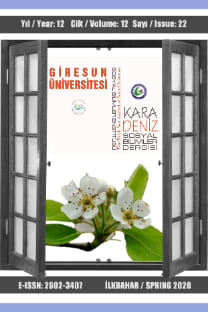Ortaokul Öğrencilerinin Üç Nokta ve Sonsuzluk Kavramına İlişkin Görüşleri
Ortaokul matematik dersi öğretim programı, Sonsuzluk, Üç nokta, Ortaokul öğrencileri
The Analysis of Secondary School Students’ Views on The Concepts of Triple Dot and Infinity
___
- Aztekin, S. (2008). Farklı Yaş Gruplarındaki Öğrencilerde Yapılanmış Sonsuzluk Kavramlarının Araştırılması. Yayınlanmış Doktora Tezi. Gazi Üniversitesi Eğitim Bölümleri Enstitüsü, Ankara.
- Bozkuş, F. (2014). Ortaokul Öğrencilerinin Sonsuzluk Kavrayışları. Yayınlanmış Yüksek Lisans Tezi. Abant İzzet Baysal Üniversitesi Eğitim Bilimleri Enstitüsü, Bolu.
- Bozkuş, F., Toluk-Uçar, Z. ve Çetin, İ. (2015). Ortaokul öğrencilerinin sonsuzluğu kavrayışları. Türk Bilgisayar ve Matematik Eğitimi Dergisi, 6(3), 506-531.
- Çelik, D., ve Akşan, E. (2013). Matematik Öğretmeni Adaylarının Sonsuzluk, Belirsizlik ve Tanımsızlık Kavramlarına İlişkin Anlamaları. Necatibey Eğitim Fakültesi Elektronik Fen ve Matematik Eğitimi Dergisi, 7(1).
- Çepni, S. (2007). Araştırma ve proje çalışmalarına giriş. Trabzon: Celepler Publications.
- Dubinsky, E., Weller, K., Mcdonald, M. A., ve Brown, A. (2005). Some historical issues and paradoxes regarding the concept of infinity: An Apos-Based analysis: Part 1. Educational Studies in Mathematics, 58(3), 335-359.
- Ervynck, G. (1994). Students' Conceptions of Infinity in the Calculus. Problems, Resources, and Issues in Mathematics Undergraduate Studies (PRIMUS), 4 (1), 84-96.
- Fischbein, E. (2001). Tacit Models and Infinity. Educational Studies in Mathematics, 48(2), 309-329.
- Güven, B. ve Karataş, İ. (2004). Sonsuz kümelerin karşılaştırılması: öğrencilerin kullandığı yöntemler. Dokuz Eylül Üniversitesi Buca Eğitim Fakültesi Dergisi, 15, 65 -73.
- İşleyen, T. (2013). Ortaöğretim öğrencilerinin sonsuzluk algıları. Kastamonu Eğitim Dergisi, 21(3), 1235-1252.
- Jirotkova, D. ve Littler, G. 2004. Insight into pupils’ understanding of infinity in a geometrical context. Proceedings of the 28th Conference of the International Group for the Psychology of Mathematics Education, Vol 3 pp 97– 104.
- Kanbolat, O. (2010). Bazı Matematiksel Kavramlarla İlgili Epistemolojik Engeller. Yayınlanmamış Yüksek Lisans Tezi. Karadeniz Teknik Üniversitesi, Fen Bilimleri Enstitüsü, Trabzon.
- Kolar, V. M., ve Cadez, T. H. (2012). Analysis of factors influencing the understanding of the concept of infinity. Educational Studies in Mathematics, 80(3), 389-412. Retrieved from http://www.springer.com/gp/ Köksal, M. S. (2006). Kavram öğretimi ve çoklu zekâ teorisi. Kastamonu Eğitim Dergisi, 14(2), 473 480.
- Maria, K., Thanasia, M., Katerina, K., Constantinos, C. ve George, P. (2009). Teachers’ perceptions about infinity: a process or an object?. Proceedings of CERME 6 sunulan bildiri (28 January- 1 February, Lyon, France, ss.1771-1780).
- Mamolo, A. ve Zazkis, R. (2008). Paradoxes as a Window to Infinity. Research in Mathematics Education, 10(2), 167-182.
- Miles, M. B., ve Huberman, A. M. (1994). Qualitative data analysis: An expanded sourcebook. California, CA: Sage.
- Milli Eğitim Bakanlığı. (2013). Ortaokul matematik dersi 5-8. sınıflar öğretim programı. Ankara.
- Monaghan, J.D. (1986). Adolescents' Understanding of Limits and Infinity. Yayınlanmış Doktora Tezi, University of Warwick.
- Narlı, S. ve Narlı, P. (2013). Sonsuz sayı kümeleri ışığında ilköğretim öğrencilerinin sonsuzluk algı ve yanılgılarının belirlenmesi. Buca Eğitim Fakültesi Dergisi, 33, 122-133.
- Özmantar, F. ( 2008). Sonsuzluk Kavramı: Tarihsel Gelişimi, Öğrenci Zorlukları ve Çözüm Önerileri. Eds. M.F.Özmantar, E. Bingölbali ve H.Akkoç. Matematiksel Kavram Yanılgıları ve Çözüm Önerileri (s.151-180). Pegem Akademi, Ankara.
- Sierpińska, A. (1987). Humanities students and epistemological obstacles related to limits. Educational Studies in Mathematics, 18(4), 371-397.
- Singer, M. ve Voica, C. (2003). Perception of Infinity: Does it Really Help in Problem Solving?. The Mathematics Education into the 21st Century Project Proceedings of the International Conference.
- Singer, M., & Voica, C. (2007). Children’s Perceptions on Infinity: Could They Be Structured?. Working Group 3. Building structures in mathematical knowledge 399, 506.
- Singer, F. M., ve Voica, C. (2008). Between perception and intuition: Learning about infinity. The Journal of Mathematical Behavior, 27(3), 188-205.
- Şimşek, H., ve Yıldırım, A. (2011). Sosyal bilimlerde nitel araştırma yöntemleri. Ankara: Seçkin Yayıncılık.
- Tall, D. O. (2001). Natural and Formal Infinities. Educational Studies in Mathematics, 48, 199– 238.
- Tall, T. ve Tirosh, D. (2001). Infinity -The Never-Ending Struggle. Educational Studies in Mathematics, 48 (2-3),129-136.
- ISSN: 2602-3407
- Yayın Aralığı: 2
- Başlangıç: 2009
- Yayıncı: -
ELİF MAMUR YILMAZ, Sema BİLİCİ
İzmir-Dikili’nin Ekoturizm ve Açık Alan Rekreasyonu Potansiyeli: Tespit ve Teklillerimiz
Ortaokul Öğrencilerinin Üç Nokta ve Sonsuzluk Kavramına İlişkin Görüşleri
Üniversite Gençlerinin Kur’an’a Dair İlgi, Algı ve Bilgileri: Giresun Üniversitesi Örneği
ABDULLAH AYGÜN, HAYRETTİN KARADENİZ
Gastronomi Turizmi Engelleri Kapsamında Çölyak
Fügen DURLU ÖZKAYA, BURCU AYŞENUR AKBULUT, Dilay TULGA
Elif MAMUR YILMAZ, Sema BİLİCİ
İZMİR-DİKİLİ’NİN EKOTURİZM VE AÇIK ALAN REKREASYONU POTANSİYELİ:TESPİT VE TEKLİFLERİMİZ
Örgütlerin Yönetimi açısından Ahilik Örgütüne Genel Bir Bakış; Tarihi Bir Araştırma
